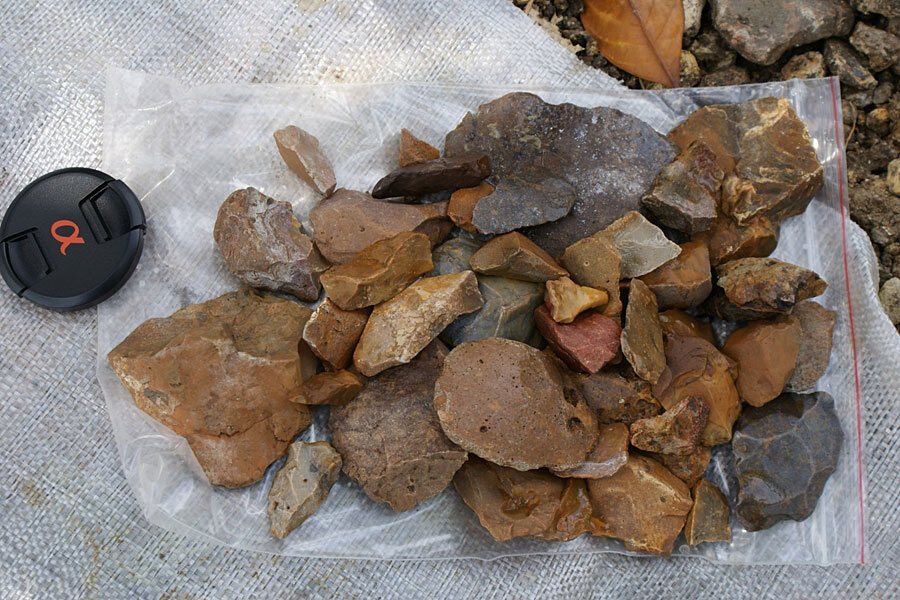'Hobbit' gets a neighbor: Stone tools hint at archaic human presence
Loading...
When early humans began trekking out of Africa, they spread across Eurasia on foot. As some made it down into then-peninsular Southeast Asia, they would have run into a watery boundary, called Wallace's Line, that scientists thought essentially uncrossable by animals until around 50,000 years ago, when Homo sapiens arrived with boat technology.
But somehow another human species had crossed into that island region, called Wallacea, long before H. sapiens even reached Southeast Asia. In 2004, archaeologists discovered fossils of an archaic human, H. floresiensis, nicknamed "Hobbit" for its stature, on the island of Flores, Indonesia.
Now, research reveals Flores may not have been the only human-populated island in the region at the time. Scientists recently unearthed stone tools on the neighboring island of Sulawesi that date to between 118,000 and 194,000 years ago.
"Our findings suggest that Sulawesi, like Flores, was host to a long-established population of archaic hominins," the researchers write in their paper published Wednesday in the journal Nature.
The humans living on these Indonesian islands "might have been much more common than we have realized so far," study lead author Gerrit van den Bergh tells The Christian Science Monitor in an interview.
But, unlike on Flores, "We don't know yet the identity of the toolmaker," Dr. van den Bergh says.
These ancient Sulawesi residents may have been members of the species H. erectus, who are known to have lived in nearby Java some 1.5 million years ago, or perhaps they were their relatives.
Archaic humans in Java are no huge surprise, as sea levels were likely low enough to connect the island to mainland Southeast Asia at the time. But Flores and Sulawesi would have been isolated islands past Wallace's Line. So when H. floresiensis was discovered, scientists began to ponder the dispersal of humans throughout Wallacea.
These early Sulawesi residents might be a piece of that puzzle. "Sulawesi is a big land mass" quite nearby Flores, paleoanthropologist Russell L. Ciochon from the University of Iowa in Iowa City, who was not affiliated with the study, tells the Monitor in an interview. "So I assumed that humans got there, but we didn't have any firmly dated evidence."
"This provides the data. Now we can build the colonization of Sulawesi into our models," says Dr. Ciochon, who researches H. erectus in Java.
Migration by sea
Van den Bergh and his team have already proposed how the Sulawesi population might fit into the dispersal puzzle. "Our working hypothesis at the moment is that the ancestors of H. floresiensis came from the North, from Sulawesi," he says.
In that scenario, the Sulawesi population would have originated from a group living on the coast in Kalimantan, Borneo.
But how did these archaic humans migrate across water?
"I don't think they had boats," van den Bergh says. "It could be that they entered the sea due to some kind of freak event, maybe a tsunami."
Although a tsunami carrying humans to colonize an island may seem outrageous, van den Bergh points out that people have survived being stranded many miles out to sea for days on end after a tsunami, including a pregnant woman in 2005. "I think tsunamis are a major part of this story," he says.
The southward ocean currents in the region would have whisked the people across the narrow waterway separating Kalimantan from Sulawesi and then later, on down to Flores.
This scenario would set archaic humans on Sulawesi significantly earlier than these newfound stone tools suggest, as humans are thought to have arrived on Flores by 1 million years ago. "These results certainly will be an incentive to do more research and try to find fossils of the maker of these stone tools," van den Bergh says.
Tool significance hinges on age
For the researchers to suggest that archaic humans were on Sulawesi, these tools had to have been used a very long time ago. So their conclusions hinge on strong dating techniques.
The researchers determined the lower end of when these tools might have been used by dating the sediments deposited around them. "Since we are dating the artefact-bearing sediments, the age of the artefacts must be equivalent or older than the burial time of sediments," another study author, Bo Li, writes in an email to the Monitor.
To date these sediments, Dr. Li and his colleagues used a luminescence dating technique. In luminescence dating, researchers can determine how much time has passed since minerals, like quartz or feldspar, were exposed to sunlight, Li explains.
When these minerals, feldspar in this case, are buried, they accumulate an "electronic charge generated by ambient radiation at light-sensitive ‘traps’ in the crystal lattice of minerals, like a battery being charged up over hundreds of thousands of years," Li says.
This operates as a luminescence "clock," Li says. In the lab, researchers can measure how long the mineral was exposed to the radiation, and therefore determine when it was last in sunlight.
This method "is probably more likely to err on the young side than on the old side," Greg Balco, a geologist at the Berkeley Geochronology Center who is not affiliated with the study, writes in an email to the Monitor. So, if anything, these tools were used even earlier than 194,000 years ago.
Dr. Balco also points out what he considers a strong point of the paper: The scientists date sediments throughout a vertical section of the sampled site. "There are ages that span a decent vertical distance in the sediments and display the correct order, i.e. sediments that are lower in the stack must be older," he says.
"It is difficult to come up with a scenario where the ages are significantly incorrect but still in the correct order – that would require a very special series of accidents."









